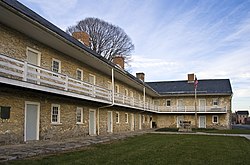| Hessian Barracks | |
|---|---|
 Main façade of the Hessian Barracks | |
| Former names | Frederick Barracks |
| Alternative names | Revolutionary Barracks |
| General information | |
| Architectural style | Georgian |
| Address | 242 S. Market St. |
| Town or city | Frederick, Maryland |
| Country | United States |
| Coordinates | 39°24′32.5″N77°24′33.8″W / 39.409028°N 77.409389°W |
| Current tenants | Maryland School for the Deaf |
| Construction started | 1777 |
| Completed | 1781 |
| Demolished | 1871 (partially) |
| Client | State of Maryland |
| Owner | State of Maryland |
| Technical details | |
| Material | Stone, wood |
| Floor count | 2 |
| Grounds | 4 acres (1.6 ha) |
| NRHP reference No. | 71000373 |
| Added to NRHP | January 25, 1971 [1] |
Hessian Barracks, formerly known as Frederick Barracks, is an historic barracks building located in Frederick, Maryland. The State of Maryland contracted to build a barracks in the summer of 1777, but it was not completed until 1781. There were two L-shaped buildings built on the site, but one was demolished in 1871. The building is a two-story stone structure with gallery porches and a gable roof. Hessian Barracks was listed on the National Register of Historic Places in 1971. [1]



